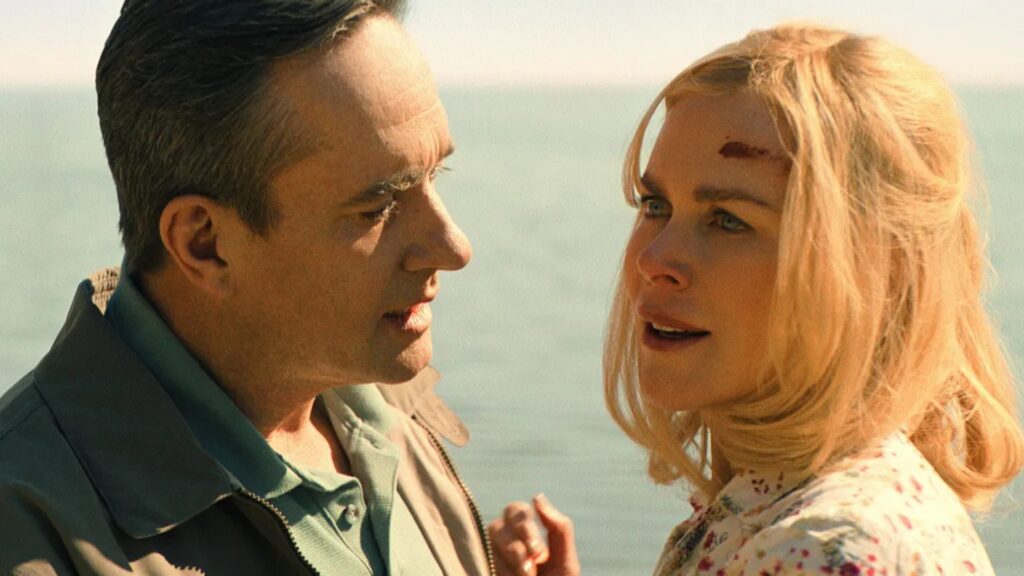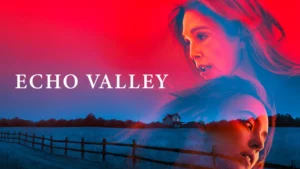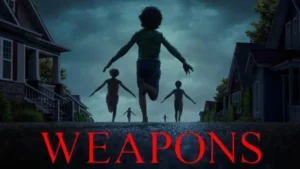Holland (2025) — a tulip-studded suburban thriller that smells of glossy menace.
Mimi Cave’s Holland arrived in spring 2025 as a strangely stylish little thriller: Nicole Kidman at the center, a Dutch-themed Midwestern town full of manicured facades, and a script that delights in raising questions about what “perfect” looks like — and what it hides. The film is visually confident and performance-driven, and it divides critics more than it unites them. Below I’ll tell you who’s in it, who the story is really about, how the film has been measured (streaming performance rather than a traditional box-office), the niche it occupies, and then go deep into plot, tone, themes, strengths and weaknesses — roughly 1,500 words of film-blogging.
Quick facts
Title: Holland (2025).
Director: Mimi Cave.
Writer: Andrew Sodroski.
Principal cast: Nicole Kidman, Matthew Macfadyen, Gael García Bernal (plus child actor Jude Hill in a key family role).
Premiere & release: World premiere at SXSW (March 9, 2025); Amazon Prime Video release March 27, 2025.
Runtime: 108 minutes.
How many cast — who’s in the movie?
If you’re counting name credit and meaningful screen time, Holland is built around a compact but heavy-hitter ensemble:
- Nicole Kidman — Nancy Vandergroot, the meticulous teacher/homeowner.
- Matthew Macfadyen — Fred Vandergroot, Nancy’s picture-perfect husband.
- Gael García Bernal — Dave Delgado, Nancy’s colleague and a catalyst for suspicion.
- Jude Hill — plays the Vandergroots’ child, a small but important presence that changes the stakes.
Beyond those leads, the credits expand to roughly 20–30 named performers including teachers, neighbors, and officials who help populate Mimi Cave’s tidy, eerily curated Holland, Michigan. In storytelling terms the film is a small-cast domestic thriller — it’s character-dense in its core and economical elsewhere. (Full cast listings are available through IMDb and film databases.)
Who is the main character?
This film wears Nancy Vandergroot (Nicole Kidman) as its skin. The plot is filtered through her surveillance-like attention: Nancy is a woman who polices details, arranges household rituals, and is primed to notice the smallest deviation from “normal.” As the narrative unfolds she’s the one whose certainties fray; the story asks whether she’s a reliable narrator, a paranoid neighbor, or a woman seeing the truth no one else will acknowledge. Kidman’s Nancy is the clear “means character” — the emotional and psychological center from whom the film’s tension radiates.
Box collection / How it “performed”
Holland was released on Amazon Prime Video rather than through a standard wide theatrical run, and in the streaming era that changes how success is measured. Rather than ticket receipts, the headline metrics are viewership, platform ranking, and attention.
- Within days of its Prime release the film was reported as #1 on Amazon Prime Video worldwide (March 29, 2025), a sign of high initial engagement.
Because streaming platforms rarely publish detailed, long-tail viewer figures, there isn’t a public “box-office” chart the way there would be for a theatrical exclusive. Instead: top-chart placement, festival buzz (SXSW), and critical hit-or-miss commentary form the surrogate measures. For Holland, that meant big early visibility on Prime accompanied by a lively, mostly mixed critical conversation.
What niche does Holland occupy?
Holland sits squarely in the psychological domestic thriller niche with shifts toward satire. Think The Stepford Wives cut with midwestern kitsch and an anxiety about the picturesque suburban ideal. It’s a movie for viewers who like tightly composed thrillers that focus on domestic microdrama rather than action spectacles — a film that traffics in suspicion, social optics, and the slow unspooling of what’s behind closed doors. If you like quiet escalation (instead of jump-scare horror), stylized production design, and performance-led tension, this is marketed for you.

Deep dive — plot, tone, craft, themes, and reception.
Premise — what the film sets up
On paper the premise is simple: Nancy Vandergroot is a meticulous Midwestern homemaker and teacher living in the quaint Dutch-themed town of Holland, Michigan. When she begins to suspect her husband, Fred, of cheating — and later notices other small irregularities — she and a colleague (Dave) start snooping. That curiosity quickly becomes an obsession; what begins as neighborly suspicion morphs into a spiral of secrets, a tulip-festival backdrop, and an increasingly destabilized protagonist who might be onto something — or might be undoing herself. The film plays with the idea that a picture-perfect life can be a thin veneer over darker truths.
Tone & style — curated unease
Director Mimi Cave (fresh from the striking tonal leaps of Fresh) leans into design: the movie is obsessively styled, from dutch-themed ornamentation to Nancy’s precise domestic rituals. Cinematography and production design make Holland look like a living postcard — which makes the cracks feel that much more uncanny. Critics generally praise the film’s look and Kidman’s commanding physical presence even when they question the narrative payoff. In short: the film is visually bold and tonally coy.
Performances — Kidman as house-spy
Nicole Kidman is the film’s lodestar. Reviews singled out her ability to hold disquiet and humor in equal measure: a woman who can flip from the brittle domestic charm of a PTA room to something more manic and desperate. Matthew Macfadyen provides the husband’s quiet counterweight — stiff, affable, and let’s-not-make-waves — while Gael García Bernal’s Dave is the instigator who invites Nancy to suspect more. Critics agree the actors do a lot of heavy lifting even when the screenplay falters in the last act.
Narrative choices — ambiguity vs. payoff
The chief friction most critics report is between Holland’s hypnotically curated atmosphere and its script’s tendency to underdeliver narratively. Several reviews say the film delights in the slow build — the paranoia, the smell of something rotten beneath tulips — but then resolves with an ending that many find either abrupt or unconvincing. In other words: the movie earns your attention in mood and performance but doesn’t entirely reward that investment in plot payoff. If you love the ride more than the destination, you’ll be more forgiving.
Themes — perfection, surveillance, and the social performance of marriage
At its best, Holland is a fable about appearances. It asks: what happens when a life has been curated for optics — for neighbors, for PTA, for the photo-op of a tulip festival — and one of the curators starts to notice the blemishes? The film nudges toward questions about gaslighting (is Nancy right or mad?), the loneliness of caretaking, and how communities collude in maintaining facades. It also riffs on small-town Americana through a satirical prism: the town’s dutchness is part costume, part brand. Those thematic strands are interesting; the film sometimes treats them as motifs more than arguments.
What works
- Kidman’s performance: she’s magnetic, nimble, and capable of carrying the film’s tonal swings. Reviewers consistently note her commitment.
- Production design & tone: Mimi Cave and her team create an unnerving postcard town; Holland’s look is a real achievement — immaculate and slightly false.
- Festival buzz & streaming reach: SXSW premiere + #1 placement on Prime helped the movie get viewers and coverage, which is valuable in the streaming age.
What doesn’t work
- Script payoff / plausibility: multiple reviewers say the final stretch is less convincing than the setup; plot twists feel padded or abrupt. That leaves some viewers with the sense that style outpaced substance.
- Tonality wobble: the film tries to be satire, thriller, and dark comedy all at once, and a few critics find the movie uncertain which hat to wear. If you prefer a thriller with a relentless tone, this middle-register film will frustrate you.
Reception snapshot (critics vs. audience)
Critical reaction is decidedly mixed. Some outlets praise Kidman’s performance and Cave’s visual control; others (notably The Guardian and RogerEbert.com) call the film a frustratingly hollow exercise in surface tension that doesn’t quite land narratively. Aggregators reflect that split: the reviews range from admiring to disappointed, with Rotten Tomatoes collecting praise for style and critique for script. Audiences who enjoy mood pieces and strong acting tend to respond more warmly than viewers who demand plot clarity.
Verdict — who will love Holland and who should skip it?
See it if you like actor-driven psychological pieces, meticulously designed worlds, and a slow-burn, mood-first thriller that favors ambiguity; if you’re a Nicole Kidman fan, this is a performance to watch.
Skip it if you want tight, logical thrillers with satisfying twist endings. If an unanswered question at the end will feel like abandonment rather than invitation, this one will annoy you.
Final thought.
Holland is a tidy little puzzle box: the outside is beautiful — immaculate houses, tulips, dutch flags — and the inside is a series of uneasy rooms in which a woman’s certainties are slowly unpicked. Mimi Cave has staged a film that’s visually distinct and anchored by a bravura Lead performance, but it’s also a film that will split viewers on whether that style is matched by narrative rigor. Depending on what you want from a thriller — ambiguity and mood, or clear answers and payoff — Holland will either be an elegant, unsettling watch or a stylish tease.






Pingback: Best The Wildman of Shaggy Creek